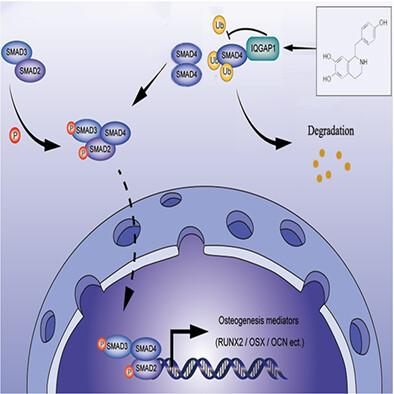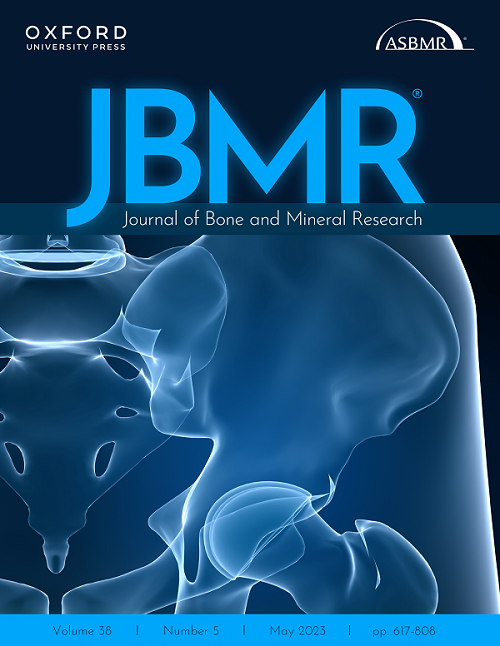求助PDF
{"title":"Higenamine通过IQGAP1/SMAD4信号通路促进骨生成,防止小鼠年龄和雌激素依赖性骨质流失","authors":"Hui Dong, Ronghan Liu, Ke Zou, Zhengxin Jin, Jianning Kang, Ying Zhang, Xiaodi Zhang, Zhengfang Sun, Guilian Yu, Nana Huang, Morgan Bretches, Shang-You Yang, Bin Ning","doi":"10.1002/jbmr.4800","DOIUrl":null,"url":null,"abstract":"<div>\n \n <p>Osteoporosis is a common bone disease caused by an imbalance of bone resorption and formation that results in a loss of total bone density. SMAD2/3 signal transduction is known to play a crucial role in osteogenic differentiation through transforming growth factor-beta (TGF-β). By screening a library of small-molecule compounds, the current study identifies higenamine (HG) as an active osteogenic agent that could be a therapeutic candidate for osteoporosis. In vitro data demonstrated that HG effectively induced expressions of osteogenic markers in mouse bone marrow stromal cell (BMSCs) and preosteoblastic cell cultures. Further, HG treatment resulted in enhanced bone formation and prevented accelerated bone loss on two animal models that mimic spontaneous senile osteoporosis and postmenopausal osteoporosis. IQ motif-containing GTPase-activating protein 1 (IQGAP1) was confirmed as a novel target of HG, where HG appears to bind to the Glu-1019 site of IQGAP1 to exert its osteogenic effects. Data subsequently suggested that HG promoted phosphorylation of SMAD2/3 and regulated the SMAD2/3 pathway by inhibiting SMAD4 ubiquitination. Overall, the findings highlight HG as a new small-molecule drug to promote bone formation through SMAD2/3 pathway in osteoporosis. © 2023 American Society for Bone and Mineral Research (ASBMR).</p>\n </div>","PeriodicalId":185,"journal":{"name":"Journal of Bone and Mineral Research","volume":"38 5","pages":"775-791"},"PeriodicalIF":5.1000,"publicationDate":"2023-03-12","publicationTypes":"Journal Article","fieldsOfStudy":null,"isOpenAccess":false,"openAccessPdf":"","citationCount":"0","resultStr":"{\"title\":\"Higenamine Promotes Osteogenesis Via IQGAP1/SMAD4 Signaling Pathway and Prevents Age- and Estrogen-Dependent Bone Loss in Mice\",\"authors\":\"Hui Dong, Ronghan Liu, Ke Zou, Zhengxin Jin, Jianning Kang, Ying Zhang, Xiaodi Zhang, Zhengfang Sun, Guilian Yu, Nana Huang, Morgan Bretches, Shang-You Yang, Bin Ning\",\"doi\":\"10.1002/jbmr.4800\",\"DOIUrl\":null,\"url\":null,\"abstract\":\"<div>\\n \\n <p>Osteoporosis is a common bone disease caused by an imbalance of bone resorption and formation that results in a loss of total bone density. SMAD2/3 signal transduction is known to play a crucial role in osteogenic differentiation through transforming growth factor-beta (TGF-β). By screening a library of small-molecule compounds, the current study identifies higenamine (HG) as an active osteogenic agent that could be a therapeutic candidate for osteoporosis. In vitro data demonstrated that HG effectively induced expressions of osteogenic markers in mouse bone marrow stromal cell (BMSCs) and preosteoblastic cell cultures. Further, HG treatment resulted in enhanced bone formation and prevented accelerated bone loss on two animal models that mimic spontaneous senile osteoporosis and postmenopausal osteoporosis. IQ motif-containing GTPase-activating protein 1 (IQGAP1) was confirmed as a novel target of HG, where HG appears to bind to the Glu-1019 site of IQGAP1 to exert its osteogenic effects. Data subsequently suggested that HG promoted phosphorylation of SMAD2/3 and regulated the SMAD2/3 pathway by inhibiting SMAD4 ubiquitination. Overall, the findings highlight HG as a new small-molecule drug to promote bone formation through SMAD2/3 pathway in osteoporosis. © 2023 American Society for Bone and Mineral Research (ASBMR).</p>\\n </div>\",\"PeriodicalId\":185,\"journal\":{\"name\":\"Journal of Bone and Mineral Research\",\"volume\":\"38 5\",\"pages\":\"775-791\"},\"PeriodicalIF\":5.1000,\"publicationDate\":\"2023-03-12\",\"publicationTypes\":\"Journal Article\",\"fieldsOfStudy\":null,\"isOpenAccess\":false,\"openAccessPdf\":\"\",\"citationCount\":\"0\",\"resultStr\":null,\"platform\":\"Semanticscholar\",\"paperid\":null,\"PeriodicalName\":\"Journal of Bone and Mineral Research\",\"FirstCategoryId\":\"3\",\"ListUrlMain\":\"https://onlinelibrary.wiley.com/doi/10.1002/jbmr.4800\",\"RegionNum\":1,\"RegionCategory\":\"医学\",\"ArticlePicture\":[],\"TitleCN\":null,\"AbstractTextCN\":null,\"PMCID\":null,\"EPubDate\":\"\",\"PubModel\":\"\",\"JCR\":\"Q1\",\"JCRName\":\"ENDOCRINOLOGY & METABOLISM\",\"Score\":null,\"Total\":0}","platform":"Semanticscholar","paperid":null,"PeriodicalName":"Journal of Bone and Mineral Research","FirstCategoryId":"3","ListUrlMain":"https://onlinelibrary.wiley.com/doi/10.1002/jbmr.4800","RegionNum":1,"RegionCategory":"医学","ArticlePicture":[],"TitleCN":null,"AbstractTextCN":null,"PMCID":null,"EPubDate":"","PubModel":"","JCR":"Q1","JCRName":"ENDOCRINOLOGY & METABOLISM","Score":null,"Total":0}
引用次数: 0
引用
批量引用



